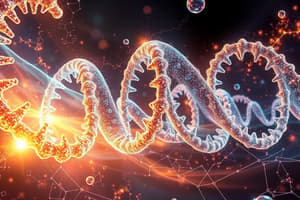Podcast
Questions and Answers
What is the primary challenge faced by synthetic helical polymers in solution?
What is the primary challenge faced by synthetic helical polymers in solution?
- They are too rigid to adopt different shapes.
- They cannot form at all in solutions.
- They degrade rapidly in the presence of air.
- They tend to lose their helical conformation. (correct)
Which property is NOT associated with helical polymers according to the content?
Which property is NOT associated with helical polymers according to the content?
- Optical activity
- Atropisomerism
- Chirality
- Electrical conductivity (correct)
What characterizes static helical polymers?
What characterizes static helical polymers?
- They are mostly used in biological applications.
- They display rapid helix inversion in solution.
- They have low helix inversion energy.
- They have high helix inversion energy. (correct)
What defines the two major rules governing the helicity of copolymers?
What defines the two major rules governing the helicity of copolymers?
Which of the following helical polymers is likely to have low inversion energy?
Which of the following helical polymers is likely to have low inversion energy?
Helical polymers can exhibit chirality due to which phenomenon?
Helical polymers can exhibit chirality due to which phenomenon?
What application areas have recently seen increased interest in helical polymers?
What application areas have recently seen increased interest in helical polymers?
Which type of helical polymer is characterized by conformational stability due to side-chain interactions?
Which type of helical polymer is characterized by conformational stability due to side-chain interactions?
How are the first synthetic helical polymers described in historical context?
How are the first synthetic helical polymers described in historical context?
What typically determines the flexibility of helical polymers in solution?
What typically determines the flexibility of helical polymers in solution?
What is the primary advantage of using a combination of chiral and achiral units in the synthesis of polymers?
What is the primary advantage of using a combination of chiral and achiral units in the synthesis of polymers?
In which application do helical polymers demonstrate enantioselective properties?
In which application do helical polymers demonstrate enantioselective properties?
What unique property of helical polymers is utilized in enhancing optical activity?
What unique property of helical polymers is utilized in enhancing optical activity?
What potential application of chiral information in helical structures has been proposed?
What potential application of chiral information in helical structures has been proposed?
How does polyacetylene's dynamic properties contribute to its application in chiral separation?
How does polyacetylene's dynamic properties contribute to its application in chiral separation?
What characteristic of biomimetic polymers is highlighted in the text regarding polyisocyanide with peptide side chains?
What characteristic of biomimetic polymers is highlighted in the text regarding polyisocyanide with peptide side chains?
What distinguishes higher-order helical structures like ‘helix-in-helix’ superstructures from simpler helical forms?
What distinguishes higher-order helical structures like ‘helix-in-helix’ superstructures from simpler helical forms?
What role do sergeants and soldiers play in the synthesis of chiral polymers?
What role do sergeants and soldiers play in the synthesis of chiral polymers?
What potential impact could synthetic helical polymers have in the field of regenerative medicine?
What potential impact could synthetic helical polymers have in the field of regenerative medicine?
Which property of metal-complexed helical polymers is emphasized in their behavior?
Which property of metal-complexed helical polymers is emphasized in their behavior?
Flashcards are hidden until you start studying
Study Notes
Helices in Nature and Synthetic Polymers
- Helices are chiral structures found widely in nature, such as the double-stranded DNA helix and protein α-helices.
- The first synthetic helical polymer was identified during studies on polyolefins, specifically isotactic polypropylene (iPP), which formed a helical shape in the solid state.
- A significant challenge remains in maintaining helical formation in solution for synthetic polymers.
Applications and Interest in Helical Polymers
- Growing interest in helical polymers focuses on their uses in catalysis, chiral recognition, and biological studies.
- Helical polymers demonstrate chirality and optical activity due to atropisomerism, where restricted rotation leads to distinct stereoisomers.
- They can be categorized based on helix inversion energy: low-energy polymers exhibit rapid helix inversion, while high-energy counterparts are conformationally stable.
Polymer Types and Rules Governing Helicity
- Enantiopure polymers like polyisocyanides and polysilanes are characterized by low inversion energy and quick helix inversion.
- Static helical polymers, such as PMMAs and certain polyisocyanides, have high inversion energy contributing to their stability.
- The ‘sergeants and soldiers’ and ‘majority rules’ govern the helicity of copolymer systems, allowing for efficient chiral polymer synthesis.
Chiral Recognition and Membranes
- Helical polymers are pivotal in enantiodiscrimination, facilitating selective adsorption and permeation in chiral applications.
- Hydrogel systems with helical polymers have demonstrated remarkable enantioselective properties.
- Static helical polymers serve as chiral stationary phases in high-performance liquid chromatography (HPLC).
Optical Activity and Catalysis
- Helical polymers can enhance optical activity from monomers to polymers through their helical structure and interactions with metal complexes.
- Dynamic helical polymers can serve as asymmetric catalysts with switchable enantioselectivity, improving the performance of organocatalysts.
Biomimetic Materials and Biomedical Applications
- A polyisocyanide with peptide side chains exhibits stress-stiffening behavior akin to biological tissues, showcasing potential in biomedical applications.
- Synthetic helical materials are likely to have significant implications in regenerative medicine due to their structural similarities to natural polymers.
Data Storage and Computational Potential
- Polymers like polyisocyanates and polysilanes are evaluated for optical data storage applications, leveraging their dynamic properties.
- Chiral information from synthetic helical polymers could provide a new approach to data storage, enhancing renewability in technology.
Higher-Order Helical Structures
- Interest is growing in complex helical structures, including superstructures and the triple-helix of stereocomplexed PMMA.
- Such configurations may enable molecular sorting based on polymer strand molecular weight, resembling natural structures like RNA and DNA.
- These developments are significant for the design of future nanomaterials, bridging synthetic and natural helices.
Studying That Suits You
Use AI to generate personalized quizzes and flashcards to suit your learning preferences.




